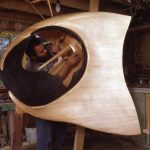Influences on Rolly’s work
Initially by my uncle John Munro, an Art Teacher/Sculptor. Then in my early days as a student of Fine Arts I was hugely moved Jacob Epstein’s ‘The Rock Drill’, Henry Moore, Barbara Hepworth and many other artists, but Moore and Hepworth actually used wood. I have always been surrounded by indigenous Oceanic and more locally New Zealand Maori art forms. This huge resource features wood abundantly but mixed with other unexpected media and processes in utilitarian and non- utilitarian forms.
First foray’s into woodturning
As an Art student in the mid 70’s I discovered wood turning while producing components for a design project. At that point I began seeing possibilities for the turned form. Also at that point I thought it may be possible to make a little money to help me though Art School by turning wooden bowls and while browsing through a book on the subject of ‘Wood’ I saw a few samples of Bob Stocksdales’s natural edged bowls.
I was not taught how to turn wood or what tools did what, I absorbed the process by osmosis, so you can imagine there were many accidents good and bad. Much of my early turning equipment was home built. I continue to maintain a keen interest in tooling.
However, art forms are a melding of technique, the physical act of making a piece and expression, the content within a work. My aim is to seamlessly blend to these elements; not to be overpowered by the joy of just boring into a piece of wood. I explore a theme before the work is started. I have worked with marine forms almost exclusively. Sketches are made, as well as samples, sometimes patterns help me gel my ideas and dictate production methods. The work may change in progress, due to the uncertain nature of wood, an artistic oversight or inspiration. Usually the drawing and sample making process irons out many issues before work on the wood starts.
Recently, the work I produce has combined turning, carving and a variety of surface treatments. An exciting voyage hopefully arriving at a unique destination. I explore while I work, often taking time out to make specialised tooling, while keeping the original concepts in sight. A typical piece would require a days’ turning but two to three weeks of other processes to complete. A slow journey, difficult to justify the time spent in any way but for the love of it.
My home is on the North Island’s south west coast, north of Kapiti. I am a few minutes drive from the sea, with mountain ranges to the east. The coastline is usually quite deserted, with ample supplies of driftwood and other flotsam to stimulate ideas. I moved there in 2008, found a nice block of land with a huge tunnel barn and built a house.
Tools
Throughout my life as a turner I have been creating my own turning and carving tools, partly because of a lack of availability, partly because of economic considerations. As far back as 1980 I was designing hollowing tools to allow me to complete large sculptural forms on a lathe. In 1990 I was Artist in Residence at Otago Art School and designed a large prototype of a deep hollowing tool. This idea was developed and commercialised. As I was having problems obtaining royalties from the manufacturer, I redesigned a much improved tool and began manufacturing them myself.





